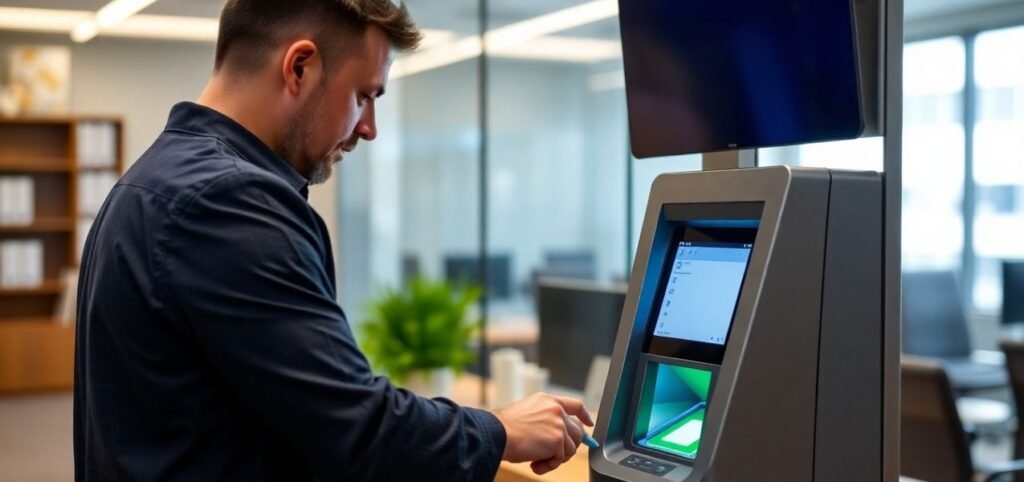Biometric machines are devices used to identify and authenticate people by measuring unique physical traits, like fingerprints, facial features, or even voice patterns. These machines are becoming increasingly popular for security purposes in workplaces, smartphones, airports, and more. With technology advancing rapidly, these machines have made security more efficient and accurate, making them a valuable asset in today’s tech-driven world.
In this blog, we’ll look at how biometric machines work, where they’re commonly used, their advantages, and some challenges they still face. By the end, you’ll have a clear idea of what these machines are and why they’re gaining so much attention.

Biometric Machines Make Us Secure
What is a Biometric Machine?
A biometric machine is a security device that identifies individuals based on their physical or behavioral traits. Traditional security methods, like passwords or ID cards, can be lost or stolen, but biometric identification relies on unique biological markers that are almost impossible to fake. Common biometrics include:
- Fingerprint Scans
- Face Recognition
- Iris or Retina Scans
- Voice Recognition
- Hand Geometry
These machines capture and analyze a person’s biometric data, such as a fingerprint or facial structure, to confirm their identity. Once this data is registered, it’s used as a reference to verify the person each time they use the machine.
How Do Biometric Machines Work?
The process of biometric identification is generally straightforward. Here’s a basic breakdown of how it works:
- Data Capture: The machine scans a part of the body, like a fingerprint or face, and captures its unique patterns.
- Template Creation: The machine then converts this biometric data into a digital format, creating a template that it stores in its database.
- Matching Process: When a person tries to access a biometric-secured area or device, the machine captures a new biometric sample. It then compares this sample with the stored template.
- Decision: If the sample matches the stored template, the person is granted access. If not, access is denied.
This process is fast, usually taking only a few seconds, and offers an efficient way to ensure that only authorized people are granted entry.
Common Uses of Biometric Machines
These machines are used in various places and industries, making everyday processes safer and more efficient. Here are some common areas where you’ll find them:
- Workplaces: Many companies use these machines to track employee attendance. Fingerprint or facial recognition machines ensure that only authorized employees can access certain areas, eliminating the need for ID cards or keys.
- Mobile Phones: Most smartphones today use fingerprint or facial recognition technology to unlock devices, allowing users to skip entering a passcode.
- Airports and Borders: These machines are used for identity verification at airports and borders, speeding up security checks and reducing the chances of identity fraud.
- Banking and ATMs: Some banks use these machines for secure banking transactions, ensuring that only the account holder can access their funds.
- Healthcare: In healthcare settings, these machines help verify patient identity, keeping sensitive medical information safe and preventing mix-ups.
These machines are becoming a part of everyday life, simplifying security processes and adding an extra layer of safety to sensitive areas.
Advantages of Biometric Machines
Biometric machines offer numerous benefits, which is why they’re becoming a preferred choice for security. Some of the key advantages include:
- High Security: Biometric machines provide a high level of security because they rely on unique traits that are difficult to replicate. This reduces the risk of unauthorized access and identity theft.
- Convenience: Unlike passwords or ID cards, biometrics don’t need to be remembered or carried. They’re always with you, making access faster and more convenient.
- Efficiency: Biometric machines can process identifications quickly, saving time in workplaces, airports, and other busy areas.
- Accuracy: With advanced sensors and software, modern biometric machines have a high accuracy rate, reducing the chances of false identifications.
- Cost-Effective in the Long Run: While the initial setup may be costly, biometric machines can save money over time by reducing the need for security personnel and managing security more effectively.
These advantages make biometric technology appealing for both personal and commercial uses, as it combines security with ease of access.
Challenges and Limitations of Biometric Machines
While biometric machines have many benefits, they also come with some challenges:
- Privacy Concerns: Biometric data is sensitive, and there are concerns about how it’s stored and who has access to it. If compromised, it could lead to identity theft.
- Technical Issues: Some biometric machines may not work well in certain conditions. For example, fingerprints might be difficult to scan if someone’s fingers are dirty or wet, and facial recognition may struggle in low light.
- Cost: High-quality biometric machines and systems can be expensive to install, which can be a barrier for smaller organizations.
- False Rejections and Acceptances: Although rare, biometric machines can sometimes reject authorized users or accept unauthorized ones due to slight variations in the biometric data, especially with aging or changes in physical appearance.
Biometric technology is continuously improving to address these challenges, and newer models of biometric machines are becoming more reliable and secure.
Conclusion
Biometric machines are changing the way we approach security. With the ability to recognize people by their unique physical or behavioral traits, these machines offer a highly secure and convenient alternative to traditional security methods. From workplaces and smartphones to airports and banks, biometric machines are making identification faster and more reliable.
While there are still some concerns around privacy, cost, and technical limitations, the advantages of biometric machines often outweigh these challenges. As technology continues to advance, it’s likely that biometrics will become an even more integral part of our lives, helping to secure sensitive information and areas with ease and efficiency.

Pingback: The Best Security Doors: Importance in Home Safety - Tech Passion